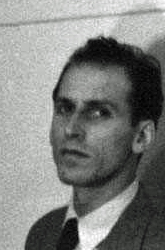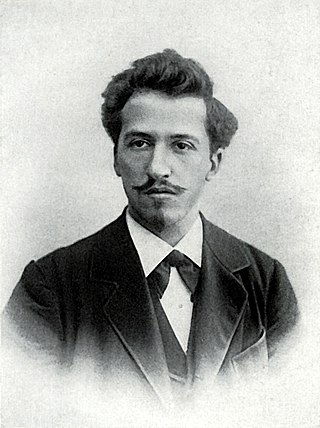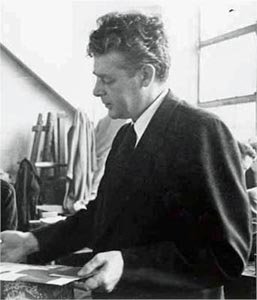
Abstract art uses visual language of shape, form, color and line to create a composition which may exist with a degree of independence from visual references in the world.

De Stijl, incorporating the ideas of Neoplasticism, was a Dutch art movement founded in 1917 in Leiden, consisting of artists and architects. The term De Stijl is also used to refer to a body of work from 1917 to 1931 created in the Netherlands. Proponents of De Stijl advocated pure abstraction and universality by a reduction to the essentials of form and colour. They simplified visual compositions to vertical and horizontal, using only black, white and primary colors.

Theo van Doesburg was a Dutch artist, who practiced painting, writing, poetry and architecture. He is best known as the founder and leader of De Stijl. He was married to artist, pianist and choreographer Nelly van Doesburg.

Broadway Boogie Woogie is a painting by Piet Mondrian completed in 1943, after he had moved to New York in 1940. Compared to his earlier work, the canvas is divided into many more squares. Although he spent most of his career creating abstract work, this painting is inspired by clear real-world examples: the city grid of Manhattan, and boogie-woogie, an African-American Blues music Mondrian loved. The painting was bought by the Brazilian sculptor Maria Martins for the price of $800 at the Valentine Gallery in New York City, after Martins and Mondrian both exhibited there in 1943. Martins later donated the painting to the Museum of Modern Art in New York City.

The Kunstmuseum Den Haag is an art museum in The Hague in the Netherlands, founded in 1866 as the Museum voor Moderne Kunst. Later, until 1998, it was known as Haags Gemeentemuseum, and until the end of September 2019 as Gemeentemuseum Den Haag. It has a collection of around 165,000 works, over many different forms of art. In particular, the Kunstmuseum is renowned for its large Mondrian collection, the largest in the world. Mondrian's last work, Victory Boogie-Woogie, is on display at the museum.

Victory Boogie Woogie is the last, unfinished work of the Dutch abstract painter Piet Mondrian, left incomplete when Mondrian died in New York in 1944. He was still working on it three days before dying. Since 1998 it has been in the collection of the Kunstmuseum, in The Hague. It has been said that "Mondrian's life and his affection for music are mirrored in the painting [and that it is] a testimony of the influence which New York had on Mondrian."
Jakob van Domselaer was a Dutch composer.
Charmion von Wiegand (1896–1983) was an American journalist, abstract painter, writer, collector, benefactor and art critic. She was the daughter of Inez Royce, an artist, and Karl Henry von Wiegand. Karl Henry von Wiegand was the German-born journalist known for wartime reporting.
Painting – artwork in which paint or other medium has been applied to a surface, and in which area and composition are two primary considerations.

Albert Carel Willink was a Dutch painter who called his style of Magic realism "imaginary realism".

Harry Holtzman was an American artist and founding member of the American Abstract Artists group.

Pieter Cornelis Mondriaan, after 1906 known as Piet Mondrian, was a Dutch painter and art theoretician who is regarded as one of the greatest artists of the 20th century. He is known for being one of the pioneers of 20th-century abstract art, as he changed his artistic direction from figurative painting to an increasingly abstract style, until he reached a point where his artistic vocabulary was reduced to simple geometric elements.

Burgoyne A. Diller was an American abstract painter. Many of his best-known works are characterized by orthogonal geometric forms that reflect his strong interest in the De Stijl movement and the work of Piet Mondrian in particular. Overall, his Geometric abstraction and non-objective style also owe much to his study with Hans Hofmann at the Art Students League of New York. He was a founding member of the American Abstract Artists. Diller's abstract work has sometimes been termed "constructivist". He also did figurative and representational works early in his career working as a muralist for the New York City Federal Arts Project.

Edna Andrade was an American abstract artist. She was an early Op Artist.

Albert Jean Gorin was a French neoplastic painter and constructive sculptor. He was a disciple of Piet Mondrian, and remained true to the concept of rigid geometricism and use of primary colors, but pushed the limits of neoplasticism by introducing circles and diagonals. He was known for his three-dimensional reliefs.

Peter Struycken is a Dutch artist, and the brother of actor Carel Struycken. The painter, computer artist and sculptor won the 2012 Heineken Prize for Arts from the Royal Netherlands Academy of Arts and Sciences. He was made a Knight in the Order of Orange-Nassau in 1984.
Carel Hendrik Blotkamp is a Dutch artist, art historian, writer and critic. He was a professor at the Vrije Universiteit Amsterdam between 1982 and 2007. Apart from his academic career Blotkamp is known for his work in art critique, writing for several newspapers and magazines. He also co-founded several art magazines. Blotkamp is considered an authority on De Stijl and magic realism, and wrote several books on modern artists.

Harriet Korman is an American abstract painter based in New York City, who first gained attention in the early 1970s. She is known for work that embraces improvisation and experimentation within a framework of self-imposed limitations that include simplicity of means, purity of color, and a strict rejection of allusion, illusion, naturalistic light and space, or other translations of reality. Writer John Yau describes Korman as "a pure abstract artist, one who doesn’t rely on a visual hook, cultural association, or anything that smacks of essentialization or the spiritual," a position he suggests few post-Warhol painters have taken. While Korman's work may suggest early twentieth-century abstraction, critics such as Roberta Smith locate its roots among a cohort of early-1970s women artists who sought to reinvent painting using strategies from Process Art, then most associated with sculpture, installation art and performance. Since the 1990s, critics and curators have championed this early work as unjustifiably neglected by a male-dominated 1970s art market and deserving of rediscovery.

Composition with Yellow Lines is an 1933 abstract painting on canvas by Dutch artist Piet Mondrian. While following the grid like structures of his other abstract paintings, it is unusual in omitting the use of any black lines. Indeed, Mondrian's earlier writings on art had stated that any lines in his paintings had to be black; colour was reserved for the filled in rectangles. The painting is equally unusual in that none of the lines meet. He did not paint any further paintings with this design element until his move to New York in 1940.

A Farmhouse Behind A Fence is a 1904 painting by the Dutch artist Piet Mondrian. It was completed early in his career, in 1904, when "the artist abruptly broke from his former life and went into rural seclusion in Brabant, a province in southern Netherlands." He painted numerous canvases on a rural theme: "in his initial public appearances as a professional artist Mondrian was more concerned with supplying a product that would sell than defining his own personal style."
















